Hoath House, Chiddingstone Hoath, Kent, Monday evening, 28 August 2000
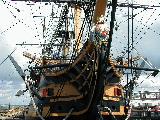 On Saturday we went back to Salisbury, to reclaim a piece of our luggage that had escaped when the tailgate of our car came open during our Wilton House expedition, and been turned in to the police in the meantime. While we were there we did laundry and internet stuff since we knew where these could be conveniently done in Salisbury. Next day we went back in that same westerly direction to visit Portsmouth. We went especially for H.M.S. Victory--Lord Nelson's flagship, left, on which he died in the battle of Trafalgar, and the most elaborate machine of its time. We also saw the remains of the Mary Rose, the first purpose-built warship of its era and pride of Henry VIII's navy, which after thirty-five years' service sank just offshore in the Solent while preparing to sail into battle. What survived of the hull was the portion that got and stayed buried in silt; it is on view during a curing process expected to last a quarter of a century, throughout which the wood is continuously sprayed with a a gradually increasingly concentrated solution of a synthetic wax. What most impressed Stas and me were the relics that had been buried with the hull: stave-built tankards, an abortive attempt at fashioning a molding plane, the barber-surgeon's hat and kit--hundreds of assorted objects, many in a vastly better state of preservation than counterparts that stayed dry for the same four centuries and a half.
On Saturday we went back to Salisbury, to reclaim a piece of our luggage that had escaped when the tailgate of our car came open during our Wilton House expedition, and been turned in to the police in the meantime. While we were there we did laundry and internet stuff since we knew where these could be conveniently done in Salisbury. Next day we went back in that same westerly direction to visit Portsmouth. We went especially for H.M.S. Victory--Lord Nelson's flagship, left, on which he died in the battle of Trafalgar, and the most elaborate machine of its time. We also saw the remains of the Mary Rose, the first purpose-built warship of its era and pride of Henry VIII's navy, which after thirty-five years' service sank just offshore in the Solent while preparing to sail into battle. What survived of the hull was the portion that got and stayed buried in silt; it is on view during a curing process expected to last a quarter of a century, throughout which the wood is continuously sprayed with a a gradually increasingly concentrated solution of a synthetic wax. What most impressed Stas and me were the relics that had been buried with the hull: stave-built tankards, an abortive attempt at fashioning a molding plane, the barber-surgeon's hat and kit--hundreds of assorted objects, many in a vastly better state of preservation than counterparts that stayed dry for the same four centuries and a half.
On our way back we visited Bosham (pronounced BOZZ'm), the port of Chichester. Its claims to fame, besides being cute, are a little church whose tower and chancel arch predate the Norman conquest, and a roadway lining the bay that floods every high tide. These are apparently enough, however, so that even at the relative unpicturesque low tide the place was fairly crawling with tourists. The chancel arch of the church stands on two blocks of stone from an an even earlier fane on this site--a Roman temple of Diana. I find it a peculiarly vivid example of Christendom's tendency to appropriate, and thus more or less obliterate, any religious signifiers that it does already own. (For further examples, consider the pre-Christian origins of just about any of the major Christian holidays.)
 Also on our way back, Stas took this photo through an open car window. We went into and past Arundel numerous times while staying at Poling. One of the best things about Arundel is its textbook medieval skyline, dominated by cathedral on one side and castle on the other. In this case neither landmark is quite so medieval as it pretends to be, but the overall effect is a rather successful counterfeit.
Also on our way back, Stas took this photo through an open car window. We went into and past Arundel numerous times while staying at Poling. One of the best things about Arundel is its textbook medieval skyline, dominated by cathedral on one side and castle on the other. In this case neither landmark is quite so medieval as it pretends to be, but the overall effect is a rather successful counterfeit.
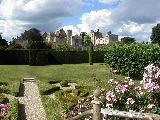



Today we visited Penshurst Place, a stately home in the Tudor style, with old-style gardens to match--in contrast to the later eighteenth-century style of landscaping that aimed at a more wild or natural look. Inside is a magnificent fourteenth-century great hall and a great deal of wonderful wood paneling, but photography is only allowed outside. The most famous of those whose house this has been was Sir Philip Sidney, who distinguished himself as poet, literary critic, soldier, and courtier in the Elizabethan period. The house was given to the Sidneys by Henry VIII, who got hold of it by the simple expedient of denouncing its previous owner for treason--which meant that the man (who had recently entertained the king here) got beheaded, and Henry got yet another fine piece of real estate to give to a crony. As Mel Brooks famously observed, it's good to be the King--or his crony.
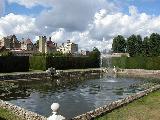
 One of many separate quadrangles enclosed by the dense square-cut yew hedges holds this goldfish pond with fountain.
One of many separate quadrangles enclosed by the dense square-cut yew hedges holds this goldfish pond with fountain.
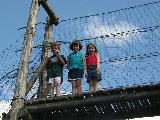 As at Wilton, a splendid playground was provided for children.
As at Wilton, a splendid playground was provided for children.
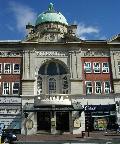 Stas had another appointment in Tunbridge Wells afterwards, and the kids and I killed time about town, with some difficulty since most places were closed for August Bank Holiday Monday. The Opera House was open, but it's merely a pub of that name now. I approve of pubs in general, but this seems a waste.
Stas had another appointment in Tunbridge Wells afterwards, and the kids and I killed time about town, with some difficulty since most places were closed for August Bank Holiday Monday. The Opera House was open, but it's merely a pub of that name now. I approve of pubs in general, but this seems a waste.
Our B&B here is an appropriate resting place after a day at Penshurst: it is a vast pile of much the same period, and also apparently kept by the current family for a good deal of its history. Even the garden is a little reminiscent of Penshurst's though far more modest. I shall try to take a few photographs and maybe ask a few questions in the morning.
Little Saltcote, Rye, Wednesday morning, 30 August
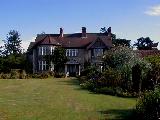 Yes, Hoath House has been in the hands of the same overall family for centuries, and in the current branch of the family for half of one, as I was informed by the young representative who served as our hostess. She regretted that her mother, who was much more up on the family into which she had married, was on holiday in Ireland and not available to answer such questions in vastly more detail. The Streatfields (pronounced Stratfields) had apparently been the local gentry over the past several centuries. Many of the photos, canvasses, and artifacts we walked or climbed past on the tortuous way to our room had suggested as much, including photos apparently showing the contemporary scions at public school or gymkhana. The photo here does not adequately capture the sprawling magnitude of the place, but at least shows a bit of the garden and (upper left) the broad bow window of our nearly four-hundred-square-foot room.
Yes, Hoath House has been in the hands of the same overall family for centuries, and in the current branch of the family for half of one, as I was informed by the young representative who served as our hostess. She regretted that her mother, who was much more up on the family into which she had married, was on holiday in Ireland and not available to answer such questions in vastly more detail. The Streatfields (pronounced Stratfields) had apparently been the local gentry over the past several centuries. Many of the photos, canvasses, and artifacts we walked or climbed past on the tortuous way to our room had suggested as much, including photos apparently showing the contemporary scions at public school or gymkhana. The photo here does not adequately capture the sprawling magnitude of the place, but at least shows a bit of the garden and (upper left) the broad bow window of our nearly four-hundred-square-foot room.
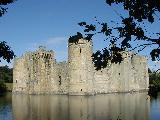
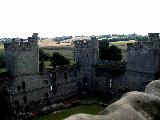
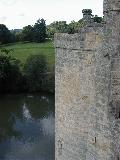

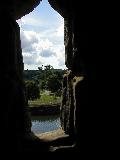
Heading back down towards the south coast, we stopped at Bodiam Castle, a late but supremely picturesque example of castle architecture. By the latter half of the fourteenth century, when the lord of the manor got his "license to crenellate" or turn the place into a castle, castles had evolved from the early Norman "motte and bailey," through various configurations of concentric fortification, into the "courtyard castle." This kind had just one layer of defensive wall, which doubled as the outer wall of a single stone building in the form of a hollow square. But by that time also the advent of artillery was already beginning to spell the end of castles as effectual defensive structures. In one of the corner towers is displayed a replica of a fourteenth-century artillery piece excavated from the moat, a wrought-iron "bombard" capable of projecting a 160-pound limestone ball a few tens of yards. This capability in itself was no real advance over older catapult technology, except perhaps in point of portability; but it was the harbinger of things to come, when high stone walls would be easy to shatter from outside. Trevor and Ariadne and I climbed the inevitable spiral stone stairs right to the tops of two of the eight towers. (There are four round ones at the corners, with rectangular ones in between; and the ones above the front and postern gates both have machicolated battlements, for defenders' convenience in dropping or pouring down harmful things on anyone assailing either gate.)
 After Bodiam we proceeded to Beachy Head, where the range of chalk hills called the South Downs is cut off by the English Channel so as to form the higher though less celebrated set of the "white cliffs of Albion" (the other set, where the North Downs meet the sea, is at Dover). We walked to the cliff top along a piece of the South Down Way (a foot-path running the full length of the range), from a point to the east along the coast. Afterwards we went to Alfriston for one of the cream teas for which the village is justly famed, and then back east here to Rye.
After Bodiam we proceeded to Beachy Head, where the range of chalk hills called the South Downs is cut off by the English Channel so as to form the higher though less celebrated set of the "white cliffs of Albion" (the other set, where the North Downs meet the sea, is at Dover). We walked to the cliff top along a piece of the South Down Way (a foot-path running the full length of the range), from a point to the east along the coast. Afterwards we went to Alfriston for one of the cream teas for which the village is justly famed, and then back east here to Rye.
previous entry
next entry
main/ToC page
 Also on our way back, Stas took this photo through an open car window. We went into and past Arundel numerous times while staying at Poling. One of the best things about Arundel is its textbook medieval skyline, dominated by cathedral on one side and castle on the other. In this case neither landmark is quite so medieval as it pretends to be, but the overall effect is a rather successful counterfeit.
Also on our way back, Stas took this photo through an open car window. We went into and past Arundel numerous times while staying at Poling. One of the best things about Arundel is its textbook medieval skyline, dominated by cathedral on one side and castle on the other. In this case neither landmark is quite so medieval as it pretends to be, but the overall effect is a rather successful counterfeit.
 On Saturday we went back to Salisbury, to reclaim a piece of our luggage that had escaped when the tailgate of our car came open during our Wilton House expedition, and been turned in to the police in the meantime. While we were there we did laundry and internet stuff since we knew where these could be conveniently done in Salisbury. Next day we went back in that same westerly direction to visit Portsmouth. We went especially for H.M.S. Victory--Lord Nelson's flagship, left, on which he died in the battle of Trafalgar, and the most elaborate machine of its time. We also saw the remains of the Mary Rose, the first purpose-built warship of its era and pride of Henry VIII's navy, which after thirty-five years' service sank just offshore in the Solent while preparing to sail into battle. What survived of the hull was the portion that got and stayed buried in silt; it is on view during a curing process expected to last a quarter of a century, throughout which the wood is continuously sprayed with a a gradually increasingly concentrated solution of a synthetic wax. What most impressed Stas and me were the relics that had been buried with the hull: stave-built tankards, an abortive attempt at fashioning a molding plane, the barber-surgeon's hat and kit--hundreds of assorted objects, many in a vastly better state of preservation than counterparts that stayed dry for the same four centuries and a half.
On Saturday we went back to Salisbury, to reclaim a piece of our luggage that had escaped when the tailgate of our car came open during our Wilton House expedition, and been turned in to the police in the meantime. While we were there we did laundry and internet stuff since we knew where these could be conveniently done in Salisbury. Next day we went back in that same westerly direction to visit Portsmouth. We went especially for H.M.S. Victory--Lord Nelson's flagship, left, on which he died in the battle of Trafalgar, and the most elaborate machine of its time. We also saw the remains of the Mary Rose, the first purpose-built warship of its era and pride of Henry VIII's navy, which after thirty-five years' service sank just offshore in the Solent while preparing to sail into battle. What survived of the hull was the portion that got and stayed buried in silt; it is on view during a curing process expected to last a quarter of a century, throughout which the wood is continuously sprayed with a a gradually increasingly concentrated solution of a synthetic wax. What most impressed Stas and me were the relics that had been buried with the hull: stave-built tankards, an abortive attempt at fashioning a molding plane, the barber-surgeon's hat and kit--hundreds of assorted objects, many in a vastly better state of preservation than counterparts that stayed dry for the same four centuries and a half.








 Yes, Hoath House has been in the hands of the same overall family for centuries, and in the current branch of the family for half of one, as I was informed by the young representative who served as our hostess. She regretted that her mother, who was much more up on the family into which she had married, was on holiday in Ireland and not available to answer such questions in vastly more detail. The Streatfields (pronounced Stratfields) had apparently been the local gentry over the past several centuries. Many of the photos, canvasses, and artifacts we walked or climbed past on the tortuous way to our room had suggested as much, including photos apparently showing the contemporary scions at public school or gymkhana. The photo here does not adequately capture the sprawling magnitude of the place, but at least shows a bit of the garden and (upper left) the broad bow window of our nearly four-hundred-square-foot room.
Yes, Hoath House has been in the hands of the same overall family for centuries, and in the current branch of the family for half of one, as I was informed by the young representative who served as our hostess. She regretted that her mother, who was much more up on the family into which she had married, was on holiday in Ireland and not available to answer such questions in vastly more detail. The Streatfields (pronounced Stratfields) had apparently been the local gentry over the past several centuries. Many of the photos, canvasses, and artifacts we walked or climbed past on the tortuous way to our room had suggested as much, including photos apparently showing the contemporary scions at public school or gymkhana. The photo here does not adequately capture the sprawling magnitude of the place, but at least shows a bit of the garden and (upper left) the broad bow window of our nearly four-hundred-square-foot room.





